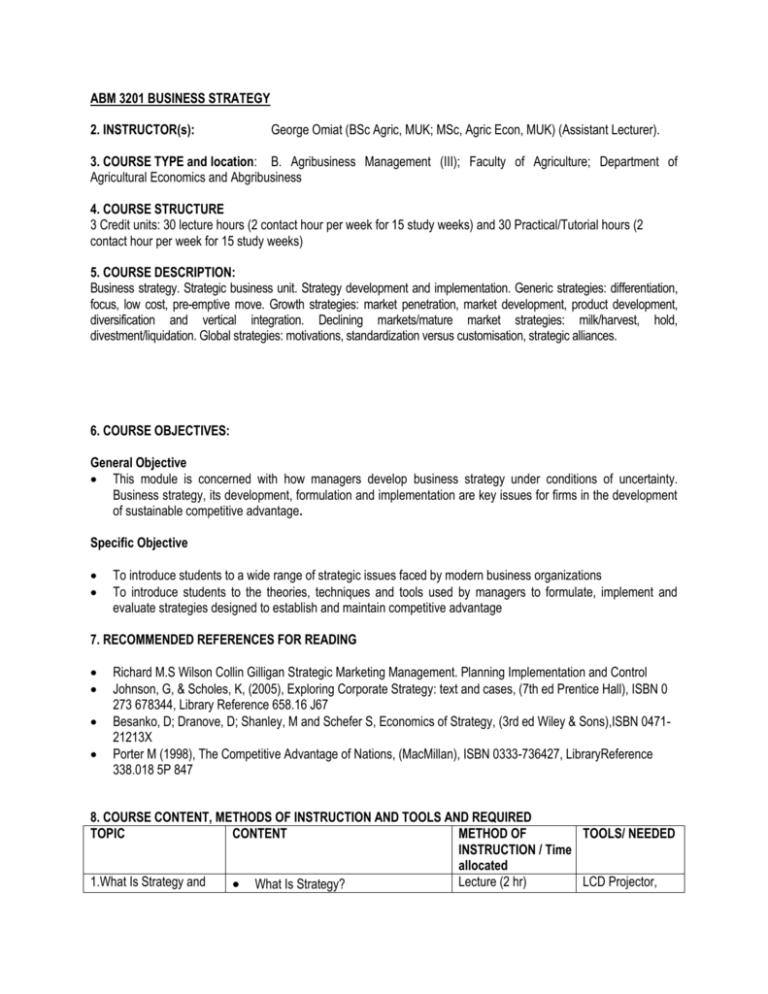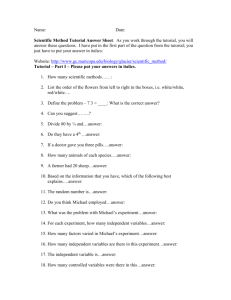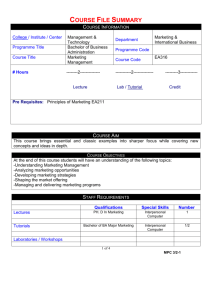ABM 3201 BUSINESS STRATEGY
advertisement

ABM 3201 BUSINESS STRATEGY 2. INSTRUCTOR(s): George Omiat (BSc Agric, MUK; MSc, Agric Econ, MUK) (Assistant Lecturer). 3. COURSE TYPE and location: B. Agribusiness Management (III); Faculty of Agriculture; Department of Agricultural Economics and Abgribusiness 4. COURSE STRUCTURE 3 Credit units: 30 lecture hours (2 contact hour per week for 15 study weeks) and 30 Practical/Tutorial hours (2 contact hour per week for 15 study weeks) 5. COURSE DESCRIPTION: Business strategy. Strategic business unit. Strategy development and implementation. Generic strategies: differentiation, focus, low cost, pre-emptive move. Growth strategies: market penetration, market development, product development, diversification and vertical integration. Declining markets/mature market strategies: milk/harvest, hold, divestment/liquidation. Global strategies: motivations, standardization versus customisation, strategic alliances. 6. COURSE OBJECTIVES: General Objective This module is concerned with how managers develop business strategy under conditions of uncertainty. Business strategy, its development, formulation and implementation are key issues for firms in the development of sustainable competitive advantage. Specific Objective To introduce students to a wide range of strategic issues faced by modern business organizations To introduce students to the theories, techniques and tools used by managers to formulate, implement and evaluate strategies designed to establish and maintain competitive advantage 7. RECOMMENDED REFERENCES FOR READING Richard M.S Wilson Collin Gilligan Strategic Marketing Management. Planning Implementation and Control Johnson, G, & Scholes, K, (2005), Exploring Corporate Strategy: text and cases, (7th ed Prentice Hall), ISBN 0 273 678344, Library Reference 658.16 J67 Besanko, D; Dranove, D; Shanley, M and Schefer S, Economics of Strategy, (3rd ed Wiley & Sons),ISBN 047121213X Porter M (1998), The Competitive Advantage of Nations, (MacMillan), ISBN 0333-736427, LibraryReference 338.018 5P 847 8. COURSE CONTENT, METHODS OF INSTRUCTION AND TOOLS AND REQUIRED TOPIC CONTENT METHOD OF TOOLS/ NEEDED INSTRUCTION / Time allocated 1.What Is Strategy and Lecture (2 hr) LCD Projector, What Is Strategy? Why Is It Important? 2. What Is Strategy and Why Is It Important? Cont’d 3.Analyzing a Company’s External Environment 4.Analyzing a Company’s External Environment cont’d Identifying a Company’s Strategy Strategy and the Quest for Competitive Advantage Strategy Is Partly Proactive and Partly Reactive Tutorial: How to identify a company’s strategy Strategy and Ethics: Passing the Test of Moral Scrutiny The Relationship Between a Company’s Strategy and Its Business Model What Makes a Strategy a Winner? Why Are Crafting and Executing Strategy Important? Tutorial: Relating a company’s strategy to the business model The Strategically Relevant Components of a Company’s External Environment Thinking Strategically About a Company’s Industry and Competitive Environment What are the Industry’s Dominant Economic Features? What Kinds of Competitive Forces are Industry Members Facing? The Rivalry Among Competing Sellers The Potential Entry of New Competitors Tutorial: How to analyze the company’s external environment Competitive Pressures from the Sellers of Substitute Products Competitive Pressures Stemming from Supplier Bargaining Power and Supplier-Seller Collaboration Competitive Pressures Stemming from Buyer Bargaining Power and Seller-Buyer Collaboration Determining Whether the Collective Strength of the Five Competitive Forces is Conducive to Good Profitability What Factors are Driving Industry Change and What Impacts Will They Have? Tutorial (2 hrs) Lecture (2 hr) Tutorial (2 hrs) Lecture (2 hr) Tutorial (2 hrs) Lecture (2 hr) Tutorial (2 hrs) BB/Chalk, Computer LCD Projector, BB/Chalk, Computer LCD Projector, BB/Chalk, Computer LCD Projector, BB/Chalk, Computer 5.The Five Generic Competitive Strategies 6. The Five Generic Competitive Strategies Cont’d 7. The Five Generic Competitive Strategies Cont’d 8. Beyond Competitive Strategy Other Important Strategy Choices Tutorial: Examining the strengths of the Five competitive forces Five Competitive Strategies Low-Cost Provider Strategies The Two Major Avenues for Achieving a Cost Advantage The Keys to Success in Achieving Low-Cost Leadership When a Low-Cost Provider Strategy Works Best The Pitfalls of a Low-Cost Provider Strategy Tutorial: Low Cost Provider strategies Differentiation Strategies Types of Differentiation Themes Where along the Value Chain to Create the Differentiating Attributes Achieving a Differentiation-Based Competitive Advantage The Importance of Perceived Value Keeping the Cost of Differentiation in Line When a Differentiation Strategy Works Best The Pitfalls of a Differentiation Strategy Best-Cost Provider Strategies The Big Risk of a Best-Cost Provider Strategy Tutorial: Differentiation strategies Focused (or Market Niche) Strategies A Focused Low-Cost Strategy A Focused Differentiation Strategy When A Focused Low-Cost or Focused Differentiation Strategy is Attractive The Risks of a Focused Low-Cost or Focused Differentiation Strategy The Contrasting Features of the Five Generic Competitive Strategies Tutorial: Focused/niche strategies Strategic Alliances and Collaborative Partnerships The Pervasive Use of Alliances Why and How Strategic Alliances are Advantageous Lecture (2 hr) Tutorial (2 hrs) Lecture (2 hr) Tutorial (2 hrs) Lecture (2 hr) Tutorial (2 hrs) Lecture (2 hr) Tutorial (2 hrs) LCD Projector, BB/Chalk, Computer LCD Projector, BB/Chalk, Computer LCD Projector, BB/Chalk, Computer LCD Projector, BB/Chalk, Computer 9. Beyond Competitive Strategy Other Important Strategy Choices Alliances and Partnerships with Foreign Companies Why Many Alliances are Unstable or Break Apart The Strategic Dangers of Relying Heavily on Alliances and Collaborative Partnerships Merger and Acquisition Strategies Vertical Integration Strategies: Operating Across More Stages of the Industry Value Chain The Strategic Advantages of Vertical Integration The Strategic Disadvantages of Vertical Integration Outsourcing Strategies: Narrowing the Boundaries of the Business Advantages of Outsourcing The Pitfalls of Outsourcing Tutorial: Strategic Alliances and Collaborative Partnerships; Merger and Acquisition Strategies; Vertical Integration Strategies and Outsourcing Strategies Using Offensive Strategies to Secure Competitive Advantage Basic Types of Offensive Strategies Choosing Which Rivals to Attack Choosing the Basis for Attack Using Defensive Strategies to Protect the Company’s Position Blocking the Avenues Open to Challengers Signaling Challengers that Retaliation is Likely Strategies for Using the Internet as a Distribution Channel Using the Internet Just to Disseminate Product Information Using the Internet as a Minor Distribution Channel Brick-and-Click Strategies: An Appealing Middle Ground Strategies for Online Enterprises Choosing Appropriate FunctionalArea Strategies First-Mover Advantages and Lecture (2 hr) Tutorial (2 hrs) LCD Projector, BB/Chalk, Computer 10. Competing in Foreign Markets 11. Competing in Foreign Markets Cont’d Disadvantages Tutorial: Offensive Strategies; Defensive Strategies; Strategies for Using the Internet as a Distribution Channel; Choosing Appropriate Functional-Area Strategies; FirstMover Advantages and Disadvantages Why Companies Expand Into Foreign Markets The Difference between Competing Internationally and Competing Globally Cross-Country Differences In Cultural, Demographic, and Market Conditions The Potential for Locational Advantages The Risks of Adverse Exchange Rate Fluctuations Host Government Restrictions and Requirements The Concepts of Multicountry Competition and Global Competition Strategy Options for Entering and Competing in Foreign Markets Export Strategies Licensing Strategies Franchising Strategies A Multicountry Strategy or a Global Strategy? Tutorial: Competing in Foreign Markets quest for competitive advantage The Quest for Competitive Advantage in Foreign Markets Using Location to Build Competitive Advantage Using Cross-Border Transfer of Competences and Capabilities to Build Competitive Advantage Using Cross-Border Coordination to Build Competitive Advantage Profit Sanctuaries, Cross-Market Subsidization, and Global Strategic Offensives Using Cross-Market Subsidization to Wage a Strategic Offensive Lecture (2 hr) Tutorial (2 hrs) Lecture (2 hr) Tutorial (2 hrs) LCD Projector, BB/Chalk, Computer LCD Projector, BB/Chalk, Computer 12. Tailoring Strategy to Fit Specific Industry and Company Situations Global Strategic Offensives Strategic Alliances and Joint Ventures with Foreign Partners The Risks of Strategic Alliances with Foreign Partners Making the Most of Strategic Alliances with Foreign Partners Competing in Emerging Foreign Markets Strategy Implications Strategies for Local Companies in Emerging Markets Tutorial: Competing in Emerging Foreign markets Strategies for Competing in Emerging Industries Challenges When Competing in Emerging Industries Strategic Avenues for Competing in an Emerging Industry Strategies for Competing in Turbulent, High-Velocity Markets Strategic Postures for Coping with Rapid Change Strategic Moves for Fast-Changing Markets Strategies for Competing in Maturing Industries Industry Changes Resulting from Market Maturity Strategic Moves in Maturing Industries Strategic Pitfalls in Maturing Industries Strategies for Firms in Stagnant or Declining Industries Strategies for Competing in Fragmented Industries Reasons for Supply-Side Fragmentation Strategy Options for a Fragmented Industry Tutorial: Strategies for competing in Emerging industries; Turbulent high velocity markets Lecture (2 hr) Tutorial (2 hrs) LCD Projector, BB/Chalk, Computer 13. Tailoring Strategy to Fit Specific Industry and Company Situations Cont’d 14.Diversification Strategies for Managing a Group of Businesses 15.Diversification Strategies for Managing a Group of Businesses Cont’d Strategies for Sustaining Rapid Company Growth The Risks of Pursuing Multiple Strategy Horizons Strategies for Industry Leaders Strategies for Runner-Up Firms Obstacles for Firms with Small Market Shares Strategic Approaches for Runner-Up Companies Strategies for Weak and CrisisRidden Businesses Turnaround Strategies for Businesses in Crisis Liquidation – The Strategy of Last Resort End-Game Strategies 10 Commandments for Crafting Successful Business Strategies Matching Strategy to Any Industry and Company Situation Tutorial: Strategies for competing sustaining growth; matching strategy to any industry and company situation When to Diversify Factors that Signal When It is Time to Diversify Building Shareholder Value: The Ultimate Justification for Diversifying Strategies for Entering New Businesses Acquisition of an Existing Business Internal Start-Up Joint Ventures and Strategic Partnerships Choosing the Diversification Path: Related Versus Unrelated Businesses Tutorial: When to Diversify The Case for Diversifying into Related Businesses Cross-Business Strategic Fits Along the Value Chain Strategic Fit, Economies of Scope, and Competitive Advantage The Case for Diversifying into Lecture (2 hr) Tutorial (2 hrs) Lecture (2 hr) Tutorial (2 hrs) Lecture (2 hr) Tutorial (2 hrs) LCD Projector, BB/Chalk, Computer LCD Projector, BB/Chalk, Computer LCD Projector, BB/Chalk, Computer Unrelated Businesses The Merits of an Unrelated Diversification Strategy The Drawbacks of Unrelated Diversification Combination Related-Unrelated Diversification Strategies Evaluating the Strategy of a Diversified Company After a Company Diversifies: The Four Main Strategy Alternatives Strategies to Broaden a Diversified Company’s Business Base Divestiture Strategies Aimed at Retrenching to a Narrower Diversification Base Strategies to Restructure a Company’s Business Lineup Multinational Diversification Strategies Tutorial: Divestiture Strategies 9. SUMMARY OF TIME NEEDED Lectures Tutorials (and assignments) 10. COURSE ASSESSMENT: Continuous assessment (Quizzes): Continuous assessment (Tutorial/Practical): Continuous assessment (Midsemester Test): University Examination: 30 hrs 30 hrs There will be Quizzes arising from Lectures covered 10% For each Tutorial/Practical there will be an assignment 10% There will be 2 mid semester tests 20% Final examination 60%




